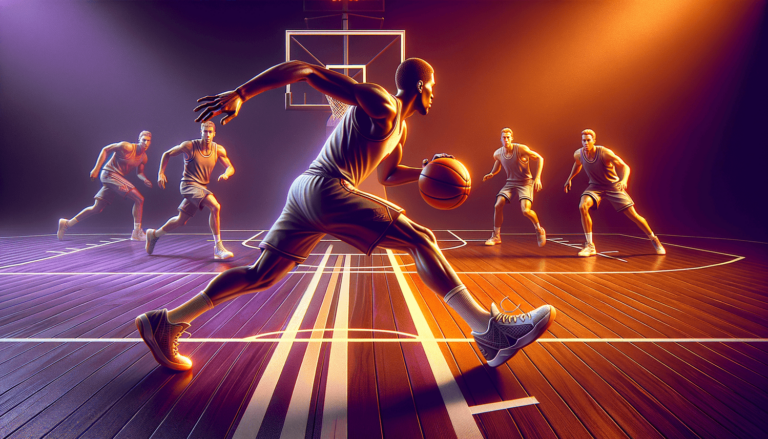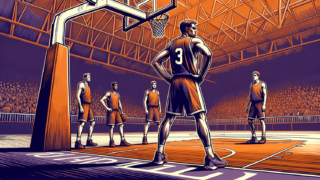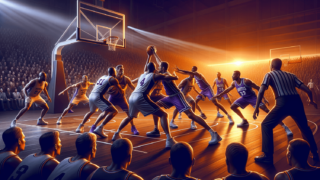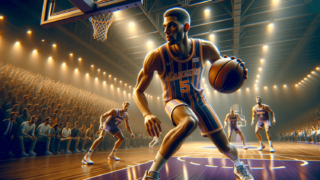
Half-Court Violation Rule in Basketball
Written by: Basketball Universe
Last updated:

Welcome to the wonderful world of basketball, where intricacies like the Half-Court Violation Rule make every game exciting and strategic! 🏀 This noteworthy rule is like an unsung hero that could potentially make or break a game. In this blog post, we take a deep dive into the realm of Half-Court Violations, dissecting the rule’s mechanics and providing fascinating insights. By the end of this post, you’ll be wowed by your newfound knowledge and ready to impress your friends during the next big game. So, lace up your sneakers and put on your virtual headband as we swish through this exciting topic that is an essential part of every basketball lover’s repertoire! 🏀
Half-Court Violation Rule in Basketball
The Half-Court Violation Rule in basketball, also known as the backcourt violation, occurs when the offensive team illegally crosses back over the half-court line after having already established frontcourt position. This rule promotes continuous play and discourages stalling tactics. If a violation occurs, the opposing team takes possession of the ball.
A Look Back in History: The Evolution of Half-Court Violation Rule
The half-court violation rule, as we know it today, has evolved substantially since the early days of basketball. In the early 20th century, basketball was played at a much slower pace, and teams would often stall the game by not crossing the half-court line. As a response to this practice that made the game less dynamic, the half-court violation rule was implemented to keep the action moving and improve the spectator’s experience.
Getting Into the Nitty-Gritty: Understanding the Half-Court Violation Rule
The half-court violation rule occurs when the offensive team crosses back over the half-court line after having already established frontcourt position. To better understand the rule, let’s break it down step-by-step:
1. Establishing Frontcourt Position
Once the offensive team has advanced the ball past the half-court line, they have established frontcourt position. This means that the offensive team’s feet and the ball must be entirely across the half-court line, even it’s just by a millimeter.
2. Backcourt Violation
A backcourt violation occurs when the offensive team, once they’ve established frontcourt position, allows the ball to return to the backcourt. The violation can occur if an offensive player touches the ball in the backcourt after it has been intentionally or unintentionally sent there by the offensive team.
3. The Exception: Deflected Balls
If a player from the defensive team actively deflects the ball into the backcourt, no violation will occur, and the offensive team is allowed to retrieve the ball. In other words, the half-court violation rule applies only when the offensive team sends the ball back across the half-court line.
4. The Penalty: Loss of Possession
If a half-court violation has been committed, the opposing team takes possession of the ball. Generally, the referee will call a violation and blow the whistle, stopping the play and allowing the defensive team to inbound the ball from the sideline.
Strategies to Avoid Half-Court Violations
To ensure smooth gameplay and minimize turnovers, it’s essential for players to have a clear understanding of the half-court violation rule and develop the skill to avoid violations. Here are some strategies to avoid half-court violations:
1. Effective Communication
Often, half-court violations occur due to a lack of communication among teammates. Effective communication is the key to letting your teammates know your intentions, so teammates can better position themselves to avoid crossing the half-court line unintentionally.
2. Court Awareness
Players should be aware of their position on the court at all times. By practicing court awareness, players can prevent turnovers resulting from unintentional half-court violations.
3. Pressure Management
During high-pressure situations, players are more likely to commit errors, including half-court violations. Developing effective ball-handling skills, passing techniques, and time management skills can help players reduce the risk of committing a half-court violation, even in high-pressure situations.
Essential Basketball Rules: Half-Court Violation and the Shot Clock
The introduction of the shot clock in the 1950s further solidified the relationship between the half-court violation rule and the need for continuous gameplay. The shot clock provided a time limit for the offensive team to attempt a shot, and this time constraint allowed for a more exciting game of basketball. The combination of the shot clock and the half-court violation rule ensured that teams couldn’t stall the game or waste time, resulting in a more fast-paced and competitive sport.
1. The 8-Second Rule
Incorporating the shot clock, FIBA introduced the 8-second rule in the late 1990s. The offensive team has 8 seconds to advance the ball past the half-court line, or they will lose possession. By adding an additional time constraint, the half-court violation rule and the 8-second rule work hand-in-hand to enforce continuous action and minimize stalling tactics.
2. The 24-Second Shot Clock
The 24-second shot clock is another essential basketball rule that works in tandem with the half-court violation rule. Once the offensive team attains frontcourt position, they have 24 seconds to attempt a shot. With this in mind, teams must be mindful of their timing, as hesitations or miscalculations may prove costly, resulting in a shot clock violation and loss of possession.
The Half-Court Violation Rule’s Impact on Basketball Culture
The half-court violation rule plays a significant role in shaping the evolution of basketball culture at various levels. Players, coaches, and fans alike have embraced the continuous gameplay and excitement that the rule brings to the sport.
1. An Exciting and Fast-Paced Game
The half-court violation rule encourages players to move the ball quickly across the court and enhances the overall pace of the game. NBA games, for instance, feature electrifying action thanks to the rule, which prevents teams from slowing the game down and forces them to maintain swift gameplay, much to the delight of spectators.
2. Developing Elite Players
Players raised in a basketball environment where the half-court violation rule is enforced from a young age are more inclined to acquire essential skills and develop into elite athletes. As players constantly need to evade defensive pressure and traverse the half-court line, they learn to think on their feet and make split-second decisions, ultimately elevating the level of the sport.
3. A Tool for Coaches and Tactics
The half-court violation rule has led to the development of specialized strategies and tactics used by coaches worldwide. Press defense, for example, is a strategy designed to exploit the half-court violation rule to force turnovers by applying high-pressure defense and trapping players near the half-court line.
Takeaways: Understanding the Half-Court Violation Rule and Its Significance
As a basketball enthusiast, it’s crucial to understand the half-court violation rule and the role it plays in shaping basketball as we know it. While it might seem like a simple rule on the surface, the half-court violation rule has influenced various aspects of the game, from strategies and tactics to the development of important core skills.
Understanding the rule not only allows you to appreciate the game on a deeper level but also improves your ability to identify potential half-court violations during gameplay. With this newfound knowledge of the half-court violation rule and its significance in basketball, you’re now one step closer to becoming a true basketball aficionado.
Refining Your Skills: Drills to Prevent Half-Court Violations
Now that you have a solid understanding of the half-court violation rule and its importance in the game of basketball, it’s essential to practice and refine skills that can help prevent half-court violations. In this section, we outline a few basketball training drills designed to create good habits and build the necessary skills to help your team avoid these costly violations.
1. Two-on-One Half-Court Drill
This drill simulates a game-like situation where two offensive players need to get the ball past the half-court line against one defender applying pressure. The aim is to improve communication, decision-making, and court awareness while under pressure. Practicing under game-like conditions will help players become accustomed to overcoming the challenges associated with the half-court violation rule.
2. Three-on-Two Full Court Press Drill
This drill helps players develop their ball-handling and passing skills under full court defensive pressure. As there will always be an open teammate, players must work on their communication and find ways to advance the ball past the half-court line without committing a violation. This drill is especially useful, as it reinforces the importance of teamwork and collaboration when navigating the half-court violation rule.
3. Half-Court Timed Relay Drill
Working on time management is crucial when facing the half-court violation rule. This timed relay drill involves each player having to dribble from the baseline to the half-court line and back within a set time frame (e.g., 8 seconds to simulate the 8-second rule in FIBA). The objective is to push players to make quick, accurate decisions while handling the ball, ultimately reducing the risk of committing a violation.
What about NCAA Basketball Rules and Half-Court Violations?
The half-court violation rule extends beyond professional basketball, with college basketball adhering to similar principles to maintain exciting, action-packed gameplay. The NCAA basketball rules are slightly different from the NBA and FIBA rules, with the NCAA using a 10-second rule to advance the ball past the half-court line instead of the 8-second rule adopted by FIBA. However, the half-court violation rule’s fundamentals and penalties remain the same, ensuring that the spirit of continuous gameplay is maintained at all levels of the sport.
Half-Court Violation Rule in Street Basketball
The half-court violation rule even permeates the world of street basketball or pick-up games. Although informal pick-up games may not have officials monitoring every play, players still respect and abide by basketball rules, including the half-court violation rule, to preserve the integrity of the game. Following this rule in street basketball ensures fair, consistent gameplay and fosters sportsmanship among players.
FAQ: Your Half-Court Violation Rule Questions Answered
In this section, we answer some common questions related to the half-court violation rule. This comprehensive FAQ aims to help you better understand the rule and its impact on basketball gameplay. So, whether you’re a seasoned basketball veteran or a newfound enthusiast, we’ve got you covered!
1. What distinguishes a frontcourt from a backcourt?
The frontcourt refers to the half of the court where the offensive team is attempting to score, while the backcourt is the part of the court behind the half-court line where the offensive team’s basket is located.
2. Can a player cross the half-court line and dribble back?
No, once a player establishes their frontcourt position by crossing the half-court line, they cannot dribble or pass the ball back into their backcourt. Doing so would result in a half-court or backcourt violation.
3. Is there a half-court violation during an inbounds play?
Yes, a half-court violation can occur during an inbounds play if the inbounder, after successfully passing the ball to a teammate, receives the ball back while still positioned in their backcourt.
4. What is the time limit for advancing the ball past the half-court line?
The time limit varies depending on the league. In the NBA, it’s 8 seconds; in FIBA competition, it’s also 8 seconds; and in NCAA basketball, it’s 10 seconds.
5. Can a player step on the half-court line without committing a violation?
After establishing frontcourt position, stepping on or touching the half-court line with the ball is considered a backcourt violation. To avoid a violation, both the player’s feet and the ball must stay entirely in the frontcourt.
6. Can a player jump from the frontcourt to the backcourt to save the ball?
A player may jump from the frontcourt to the backcourt to save the ball as long as they release the ball in mid-air before landing in the backcourt. Failing to accomplish this would result in a half-court violation.
7. Is it a violation when a dribbling player momentarily loses control of the ball and it crosses the half-court line?
Yes, if a player dribbling the ball in the frontcourt loses control and the ball crosses the half-court line, then the player touches it in the backcourt, it’s considered a backcourt violation.
8. What happens if the defense deflects the ball into the backcourt?
If the defensive team intentionally deflects the ball into the backcourt, the offensive team can legally retrieve the ball without committing a half-court violation.
9. How does the 24-second shot clock relate to the half-court violation rule?
The 24-second shot clock indirectly complements the half-court violation rule by preventing teams from stalling the game, forcing them to attempt a shot within 24 seconds, further promoting continuous action and providing an exciting game experience.
10. Are there any specific strategies to force the opposing team to commit a half-court violation?
Yes, one common strategy is the full-court press, which involves applying high-pressure defense from the inbound pass, aiming to trap players and force turnovers, including the half-court violations, by making it difficult for the offensive team to advance the ball past the mid-court line.
Featured Posts
- No pillar pages found.





